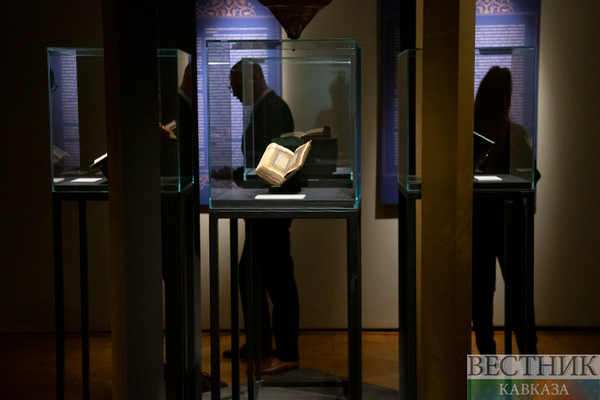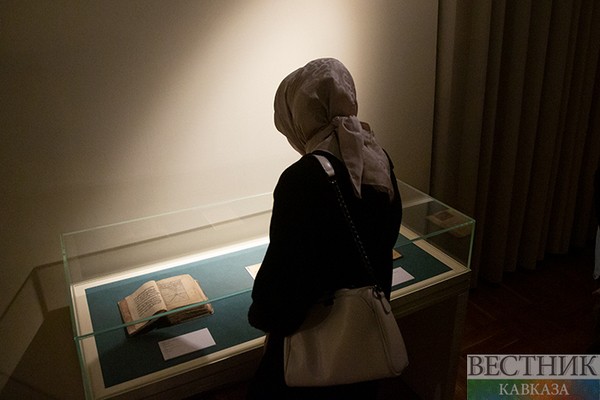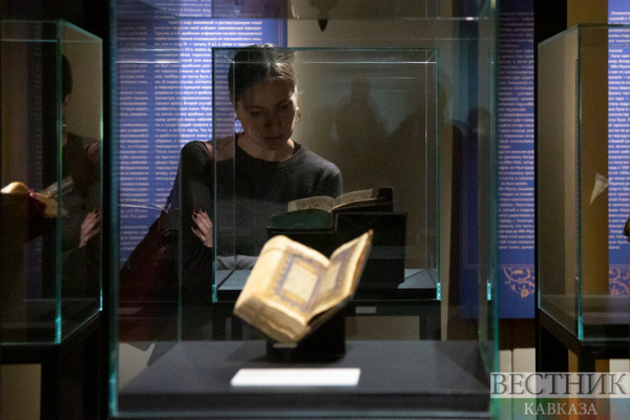The Uzbek team carved out a beautiful and integral part within the Islamic Arts Biennale by showcasing 17 ethnography and textiles of the Islamic period. Visitors will have an opportunity to witness the treasure trove of Uzbekistan artifacts brought in for the first time at the first ever Islamic Arts Biennale.
Vestnik Kavkaza reported earlier about Qurans from around the world at the Museum of Oriental Art in Moscow.
The collections on display came in from the State Museum of Arts of Uzbekistan, the State Museum of History of Uzbekistan, the Samarkand Museum-Reserve, as well as the original book “Al-Jami as-Sahib” by Imam al Bukhari. But most of all, the true gems were two legible pages of one of the oldest Uzbek Qurans. They make their world premiere at the Islamic Arts Biennale, Arab News writes.
The Katta Langar Quran
Soft spoken, eloquent and elegant, Gayane Umerova, the executive director of the Art and Culture Development Foundation under the Cabinet of Ministers of the Republic of Uzbekistan has eyes glistening as bright as the golden threads in the garments on display.
The Katta Langar Quran from the eight century is one of the oldest manuscripts in the Islamic World and is named after an Uzbek village. The Quran has a significant place in this exposition, as 13 pages were restored recently in cooperation from specialists of the Louvre Museum in Paris. At the Islamic Arts Biennale, four of those pages will be showcased, two of which will be seen by the public for the very first time ever.
“It's the first time I would say those pages are shown outside of Uzbekistan. It was kept in quite bad shape before it was restored—it was really kept not as an object to be shown at art institutions, it was more used as an object of research. For us it was a great success what we did in Paris but also was very privileged to bring it here to Saudi, as we consider it the cradle of Islamic culture. It was very important for us also to have our own kind of saying in this exhibition,”
-Gayane Umerova, the executive director of the Art and Culture Development Foundation under the Cabinet of Ministers of the Republic of Uzbekistan, said.
Qurans and more
The 17 chosen objects of ethnography and textile will represent the Islamic period in the arts and crafts of Uzbekistan. In addition to the Katta Langar Quran, ceramic jugs and mugs from Samarkand and Afrasiyab of the 10th-12th centuries and a selection of flamboyant menswear, boots and other unique artifacts are on display.
“The Biennale of Islamic Art is an important international event that gives the platform to showcase projects centered around Islamic culture. Uzbekistan has a rich and complex history, a big part of which is deeply connected to the traditions of Islam. We are presenting a selection of various objects that will serve to promote these vital traditions globally,”
-Umerova said.
The curatorial team of the Biennale of Islamic Art in Jeddah includes experts from Saudi Arabia, the UK, the US and South Africa.
“It was very important to show different angles of the culture. From the oldest piece that we bring, the Quran, to the youngest, the men’s garments because it's considered to be 19th century. We really tried to not to forget about our kind of Islamic heritage because we are a secular state, but we're very close to the Islamic culture,”
- Umerova admitted.
Many in Hejaz have Uzbek roots and this offers them a glimpse to see something authentic from their origins.
“There is not so many events in the world happenings where we can feel brotherhood or sisterhood, you know, in a way. And I think this is a great cultural event,”
-Umerova conducted.

Who is Gayane Umerova
She started her career as a senior curator at the Art Gallery of Uzbekistan in 2008. In 2012, she joined Sotheby’s as research assistant at the Russian department. In 2013, she was awarded a prize for the Artists’ Union of CIS countries art confederation for “Observations of the Unseen World” project discovering Islamic ornamental system in art of Central Asia. She worked for Christie’s for one year ending in 2015 before being appointed as deputy executive director of the Art and Culture Development Foundation. In 2020, she was promoted to her current positions and has initiated ambitious projects for the foundation abroad and in Uzbekistan. In 2011 she curated the 6th Tashkent International Biennale of Contemporary Arts in Uzbekistan. She is also the secretary general of the National Commission of the Republic of Uzbekistan for UNESCO.
Created under the decree of the Uzbek President Shavkat Mirziyoyev, the Art and Culture Development Foundation, under the cabinet of ministers of the Republic of Uzbekistan was founded in 2017. Its aim is to foster international cooperation and promotes the culture of Uzbekistan on the international stage.
What is the aim of the Islamic Arts Biennale
Organized by the Diriyah Biennale Foundation and the Ministry of Culture of Saudi Arabia, the Islamic Arts Biennale hopes to connect “the past, present, and future” by showcasing a vibrant display of Islamic artistry. The biennale will be held on the territory of the Hajj Terminal. An additional 70,000 square meter space will also be created for the biennale, to host exhibition areas, a theater, a mosque, workshops, shops and restaurants.

The Uzbek program includes public talks, music performances and workshops that bring the cultural heritage of the Islamic period of Uzbekistan to life. Also a screening of the 1924 silent film ‘The Minaret of Death’ in addition to workshops in suzani, which is a type of embroidered and decorative tribal textile made from countries such as Uzbekistan.
“It is a great honor for us to present priceless exhibits from Uzbekistan at the Islamic Arts Biennale. An important task of the Foundation is to disseminate and demonstrate the rich heritage of our country to an international audience, as well as to establish strong international cooperation,” -
- Saida Mirziyoyeva, Deputy Chairman of the Council of the Art and Culture Development Foundation of the Republic of Uzbekistan said in a statement.
According to Umerova, the Islamic Arts Biennale is an important international event that allows for the showcasing of projects related to Islamic culture and an opportunity for Saudi visitors to be immersed in the theme. Uzbekistan has a rich and multifaceted history, most closely connected with Islam’s traditions, and the selection of exhibits presented by Uzbekistan is designed to interest the visitors at the Islamic Arts Biennale and Saudi community.
The 17 objects will be on display until April 23 when the Islamic Arts Biennale concludes.






